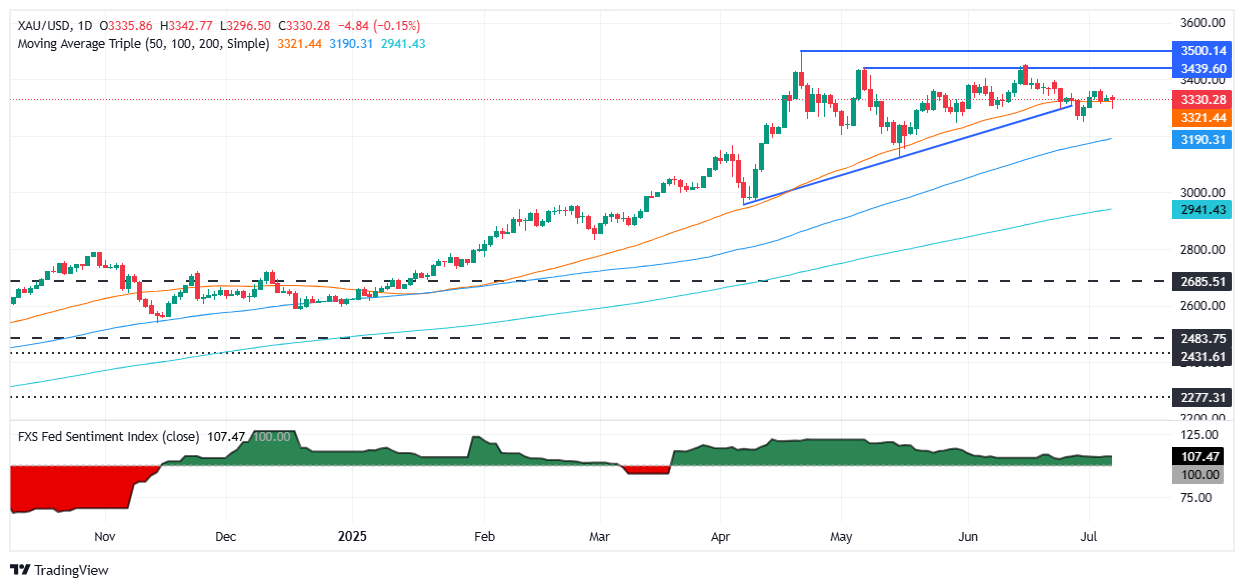- The price of gold falls 0.06%, quoting about $ 3,333 in the middle of renewed commercial tensions in the US.
- Trump threatens 25% tariffs to Korean and Japanese products, effective as of August 1.
- The feeling of risk aversion promotes US yields and the US dollar, weighing over gold.
- The Central Bank of China increases its gold reserves for eighth consecutive month.
The price of gold records minimal losses on Monday, since concerns about the resumption of a possible commercial war increase, after the announcement of the US president, Donald Trump, on their social media platforms about the first commercial letters sent to South Korea and Japan, which establish tariffs on goods and products. At the time of writing, the XAU/USD is quoted at $ 3.333, with a fall of 0.06%.
The commercial war continues after Trump announced 25% tariffs on all Korean and Japanese products sent to the US, as of August 1. The yields of the US Treasury bonds have increased, as are the US dollar. Gold prices had seen a recovery, but remain down as the appetite for risk deteriorates with the fall of US variable rental markets.
Meanwhile, economic data showed that Trump’s desire for lower interest rates is wrong, after the solid report of non -agricultural payroll last week for June. The figure exceeded May estimates and numbers, pushing the unemployment rate down. After the data, the operators discounted 14 basic points (PBS) to only 50, according to data from the Chicago Commerce Board.
Gold prices are ready to increase, since the data revealed that the Central Bank of China added the yellow metal to its reserves in June for eighth consecutive month.
This week, the operators will be attentive to the minutes of the last monetary policy meeting of the Federal Reserve (FED) and the speeches of a series of Fed officials. Together with this, the initial applications numbers of unemployment subsidy for the week ending on July 5 will update the state of the US economy.
What moves the market today: the price of gold goes back while US yields jump
- The bullish price of gold remains stagnant due to the high yields of the US Treasury bonds The 10 -year Treasury Bonus yield performance raises four basic points to 4,389%. The real US yu.
- The US dollar index (DXY), which tracks the yield of the dollar against a foreign exchange basket, shot 0.59% to 97.55, approaching 97.66, the highest level in the last eight days.
- Last week, the US Employment Report added 147K, slightly above the 110K expectations and above the May 144,000. The unemployment rate decreased to 4.1% from 4.2%, supporting the cautious and waiting approach of the Fed president, Jerome Powell, while the Fed tracks the possible inflationary impact of commercial tariffs.
- The Popular Bank of China (BOC) revealed that it has added 70,000 tons, which means that the golden bank reserves increased by 1.1 million since purchases resumed last November.
- The Bank of America revealed that the central banks that increase their gold reserves reduce their dependence on the US dollar, and is a coverage against inflation and economic uncertainty. Therefore, a greater increase for gold is expected.
Xau/USD technical perspective: The price of gold is listed laterally below $ 3,350
The upward trend of the gold price remains intact, with the yellow metal currently above the single mobile (SMA) of 50 days at $ 3.320. This is the first support line in which buyers have been supporting during the last four days of negotiation. However, a daily closure below this last will expose the level of $ 3,300.
The relative force index (RSI) remains flat, indicating that the Xau/USD could be quoting at the top/lower part of the level of $ 3,300 in the short term.
If the gold is maintained above the 50 -day SMA, the next resistance would be $ 3,350, followed by the level of $ 3,400. On the contrary, a test of the level of $ 3,300 is expected, followed by the minimum of June 30, $ 3,246. This level is critical for buyers because, once exceeded, the next demand zone would be the minimum of May 15, $ 3,120.

GOLD – FREQUENT QUESTIONS
Gold has played a fundamental role in the history of mankind, since it has been widely used as a deposit of value and a half of exchange. At present, apart from its brightness and use for jewelry, precious metal is considered an active refuge, which means that it is considered a good investment in turbulent times. Gold is also considered a coverage against inflation and depreciation of currencies, since it does not depend on any specific issuer or government.
Central banks are the greatest gold holders. In their objective of supporting their currencies in turbulent times, central banks tend to diversify their reserves and buy gold to improve the perception of strength of the economy and currency. High gold reserves can be a source of trust for the solvency of a country. Central banks added 1,136 tons of gold worth 70,000 million to their reservations in 2022, according to data from the World Gold Council. It is the largest annual purchase since there are records. The central banks of emerging economies such as China, India and Türkiye are rapidly increasing their gold reserves.
Gold has a reverse correlation with the US dollar and US Treasury bonds, which are the main reserve and shelter assets. When the dollar depreciates, the price of gold tends to rise, which allows investors and central banks to diversify their assets in turbulent times. Gold is also inversely correlated with risk assets. A rebound in the stock market tends to weaken the price of gold, while mass sales in higher risk markets tend to favor precious metal.
The price of gold can move due to a wide range of factors. Geopolitical instability or fear of a deep recession can cause the price of gold to rise rapidly due to its condition of active refuge. As an asset without yield, the price of gold tends to rise when interest rates lower, while the money increases to the yellow metal. Even so, most movements depend on how the US dollar (USD) behaves, since the asset is quoted in dollars (Xau/USD). A strong dollar tends to keep the price of gold controlled, while a weakest dollar probably thrusts gold prices.
Source: Fx Street
I am Joshua Winder, a senior-level journalist and editor at World Stock Market. I specialize in covering news related to the stock market and economic trends. With more than 8 years of experience in this field, I have become an expert in financial reporting.







